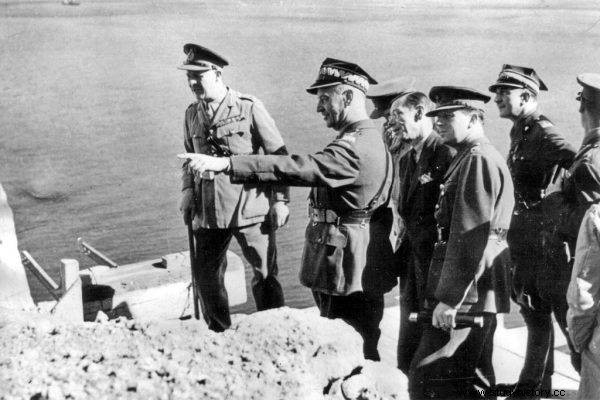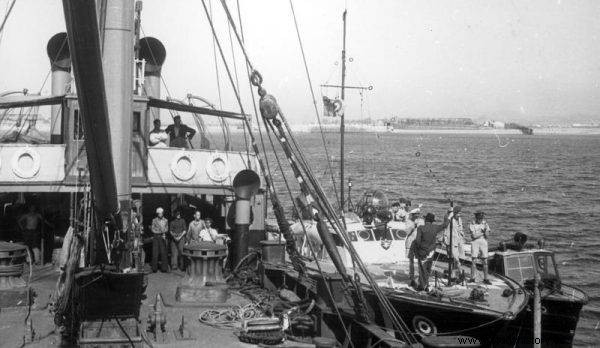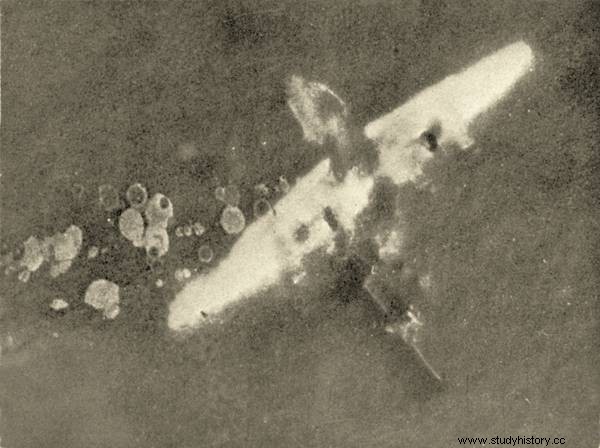It is still unknown what were the reasons for the crash of Liberator with General Sikorski on board. British archives are still unavailable, and numerous theories of the bombing resemble those born after the Presidential Tupolev's crash.
One of the most recognizable photos of General Władysław Sikorski shows the Prime Minister and the Supreme Commander boarding the Liberator plane. On July 4, 1943, the Commander-in-Chief was last seen boarding such a plane. The journey went on, among others, Sikorski's daughter, Zofia Leśniowska, the general's adjutant, his secretary, two British, a six-person flight crew - 17 people in total.
Moments later, about half a kilometer from the Gibraltar Rock, the plane began to fall into the sea. The machine crashed into the water surface, turned over in the water and began to sink. An alarm was announced, headlights illuminated the sinking machine . When the rescue boats arrived, the plane was lying on the bottom with the landing gear up. Only the pilot, Capt. Edward Max Prchal. All passengers and the rest of the crew died. Sikorski's body was found with numerous wounds. Some bodies could not be found, including that of Zofia Leśniowska.
The Liberator, turned into a VIP lounge, was the same machine that the Commander-in-Chief traveled on his way to the Middle East to inspect Polish troops, and on his way back he stopped at Gibraltar. Moreover, Sikorski himself asked the British to assign him this Liberator and his crew. He appreciated the skills and competences of the Czech captain.
Prime Minister, general, unassigned officer, Supreme Commander at last
Władysław Sikorski made himself known during the battles for the borders of the Second Polish Republic, he was the commander of the military district in Lviv. His career accelerated in the first years of the new Poland, he was even prime minister for a short time. During the May coup he did not support Piłsudski, which determined his later career. Suffice it to say that in September 1939 he was left without a military assignment. He managed to get to France during the September fights, where he was rebuilding the Polish Army and the government in exile . He headed it, and the president appointed Sikorski the Commander-in-Chief and the Inspector General of the Armed Forces. Sikorski also played against his opponents from the Sanacja circles, in a similar way to the sanatoriums on him.

General Sikorski during an earlier visit to Gibraltar in 1941. On the left the governor Macfarlane, on the right in the foreground Victor Cazalet, and behind him in the coronet, General Tadeusz Klimecki. The civilian behind Sikorski is Józef Retinger
One of the most significant events related to Sikorski at that time was the establishment of diplomatic relations with the Union of Soviet Socialist Republics, thus regulating the disputes. The agreement was signed on July 30, 1941 in London by Sikorski and the Soviet ambassador to Great Britain, Ivan Majski, hence the name of the Sikorski-Majski agreement. Sikorski was a sober-minded politician. Even after breaking diplomatic relations with the USSR (the Katyn affair), he realized that Poland's fate could rest in the hands of the Soviets and it is necessary to agree with them. General Sikorski was recognized by the Allied allies, he was a great authority in the country, he gave people hope:"the higher the sun, the closer Sikorski".
Assassination or accident?
Immediately after the catastrophe, people began to wonder what was causing it. The commission investigating the cause of the crash consisted only of British airmen. An additional team member from the Polish side was not allowed to ask questions . Representatives of the aircraft manufacturer were also not admitted. As the official cause of the disaster:jammed elevator lines.
Theories about the attack quickly emerged. Of course, they were used by German propaganda, accusing the British and Russians of the attack. Many years have passed and the matter is still not finally clarified, which favors various conspiracy theories. Some of them resemble today's strange expert opinions, e.g. with the use of a metal can, used to explain the presidential plane crash in Smolensk.

July 5, 1943:search for the bodies of the victims
For example, there were opinions that the first divers found the body of Zofia Leśniowska, but did not recover it, superstitiously fearing that touching the drowned woman's hair would bring them misfortune . Military scuba divers! Propagators of history, as a conspiratorial vision of history, claimed that Liberator's passengers were no longer alive before take-off, and the accident was supposed to cover up the attack.
In November 2008, the general's body at Wawel was examined in detail. It was established that the general died as a result of injuries of many organs, typical of victims of communication disasters.
At the end of 2013, the Institute of National Remembrance discontinued the investigation into Sikorski's death. Prosecutors decided that sabotage could neither be confirmed nor ruled out; however, they ruled out that the assassination attempt on General Sikorski had taken place before the start from Gibraltar.
If an attack, who?
Regarding the Tupolev crash, the assassination theory has one weakness:who was to do it, and for what? In theory, the attack on Sikorski makes the case more complicated. The Russians certainly benefited from this, as they aimed at severing relations with the Polish government in exile, predicting that their troops would occupy Poland . A valued and recognized politician, the realist was against them. However, the Soviets had very limited possibilities to attack Gibraltar. The British conspiracy theory is rather the aftermath of German propaganda. Why would they remove a predictable politician who would be easier to communicate with? Would they sacrifice their people? For the Germans, the catastrophe was handy to quarrel the Allied camp.

Liberator wreck of gen. Sikorski on the bottom of the Mediterranean Sea near the coast of Gibraltar. Oil stains visible in the photo.
British documents could clarify the matter, but the British extended their secrecy until 90 years, i.e. until 2033.
